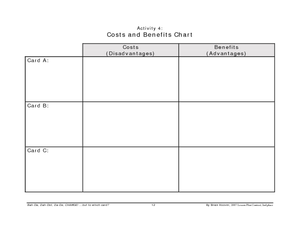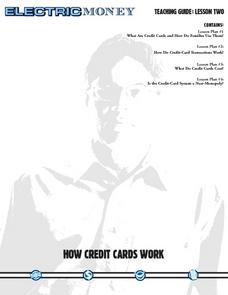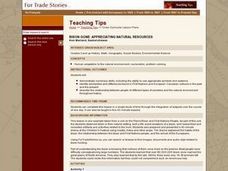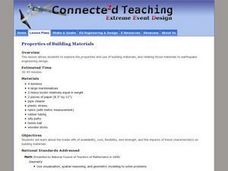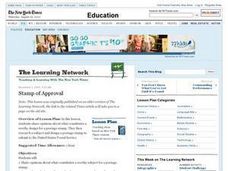Curated OER
Charge Cards!
Students identify and define the various types of credit cards and credit card offers. For this credit cards lesson, students identify the pros and cons of managing a credit card account. Students locate information on the Federal...
Curated OER
Colonial Currency
Fifth graders develop a common currency. For this colonial currency lesson, 5th graders exchange beads, rice, coins, and paper bills for goods and services. Students explore web tools to research ways colonists used money, even if it was...
Curated OER
I Have No Money, Would You Take Wampum
Students engage in a discussion about their experiences with goods, services, and money. In this bartering lesson, students read The Wampum Bird story and brainstorm their personal experiences with economics.
Curated OER
Making Good Decisions
Students analyze the consequences that result from their choices. In this good decision-making instructional activity, students listen to an article in the "Little Planet Times" and complete the associated worksheet. They participate in...
Curated OER
Cells: Structures and Processes
Students explore the basic unit of life, the cell in this nine lessons unit. The cell structure of animal and plant cell functions and how they affect our world are probed in this unit.
Curated OER
Writing Environmental Laws Refer To Reading Material
Students examine the steps and decisions that are made when drafting an environmental statute. They examine the interplay of opinions, values, beliefs, and science in the development of law. They identify methods to obtain information...
Alabama Learning Exchange
Alabama Biographies of the 20th Century
Students research and examine the lives of famous people who have changed the history of Alabama. They write a short biographical summary and create a 3-D scan picture.
Curated OER
How Credit Cards Work
Students discuss the nature and use of credit cards. They view a video about the role of credit cards and the whole idea of consumer credit. They examine the benefits and disadvantages to both merchants and consumers.
Curated OER
Border to Border
Students use the Internet to gather information on the country of Mexico. They also discover the culture of their people and compare them with the United States population. They take a virtual tour of some of Mexico's most historical ruins.
Curated OER
Lewis and Clark and Native Americans, Part II
Students research the Native Americans living in the regions explored by Lewis and Clark. They identify the modern-day names of sites claimed by the Lakota Indians, and create a poster of the original Native American names.
Curated OER
An Introduction to Islam and Muhammad
Students view a video regarding Islam and take notes on the video as they watch it. They complete a vocabulary sheet, timeline sheet, and worksheet regarding what they learned about Islam.
Curated OER
Bison Gone: Appreciating Natural Resources
Young scholars examine the effects of the loss of the bison after the Europeans arrived in North America. They conduct a demonstration using beans to demonstrate the difference between the number of bison before and after the arrival of...
Curated OER
Properties Of Building Materials
Students investigate the concept of building materials and how they are used to create different things. They focus upon the availability, cost, flexibility, and strength of different building materials. This is done by taking part in a...
Curated OER
The Roots of Religion: Teacher’s Guide
Students explore ancient cultures. In this ancient religions lesson, students study the civilizations of ancient Mesopotamia they watch "Garden of Eden" and discuss their impressions. Students then research Sumer and prepare...
Curated OER
Medieval Money
Students investigate the history of money as it was back then compare to now. In this algebra lesson, students analyze the type of money used in medieval times, the value of the currency and the coins used. They make a budget using...
Curated OER
Amidst the Rubble of Ruined Cities
Students, in committees, develop and propose solutions to rebuild various elements of Colombia's infrastructure in the wake of the January 25, 1999 earthquake, as well as compare and contrast the earthquake's affects on Colombia to an...
Curated OER
On the Road with Marco Polo
Students follow Marco Polo's route to and from China. They explore the geography, local products, culture, and fascinating sites of those regions. They record their findings.
Curated OER
Trekking to Timbuktu: Restoring the Past
Students describe the environmental conditions that presently threaten Timbuktu. They explain what efforts are being made to restore the ancient mosques, describe the condition of the ancient manuscripts and tell what is being done to...
Curated OER
Creating a Textile Museum Piece from the Islamic Empire
Students create a drawing of an Islamic textile piece from the height of the Islamic Empire. Students describe the textile designs as symbolic representations of life in Islam during the 11th and 12th centuries.
Curated OER
Hot Commodities in Turm-Oil?
Young scholars assess their daily consumption of oil and petroleum-based products. They examine current global oil supply situation.
Curated OER
Life Savers?: Exploring Ethical Dilemmas Regarding AIDS Treatment in South Africa
Students participate in a roundtable forum to discuss the notion of defying South African national government policies in order to fight AIDS after reading the online article, "A Bold Move on AIDS in South Africa."
Curated OER
Long-Lasting Impressions
Young scholars evaluate how their reactions to certain images have been altered by the events of September 11, 2001 and the subsequent world events that followed. They share their personal memories associated with that day.
Curated OER
Under the Collar
Students first examine different types of white-collar crimes; they then research recent individual cases to present in a student-written and produced expos?? program on white-collar crime.
Curated OER
Stamp of Approval
Students share opinions about what constitutes a worthy design for a postage stamp. They research a subject and design a postage stamp to submit to the United States Postal Service.


